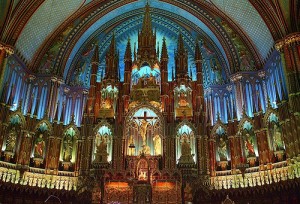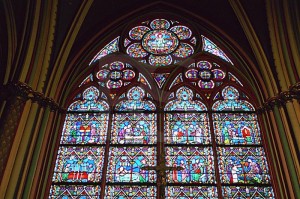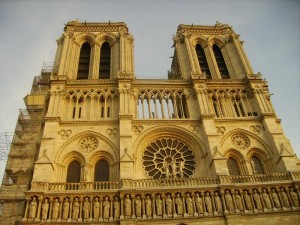Most Famous Gothic Cathedrals
The Cathedral church of Our Lady, normally referred to simply as ‘Notre Dame’, stands on the lie de la Cite in the centre of Paris. The site had formerly been occupied by two ancient churches dedicated to St Stephen and St Mary, the origins of which stretch back to the 5th Century.
The building of the present cathedral commenced in the middle of the 12th Century, when its foundation stone was laid by Pope Alexander III. At the time of its construction it was the biggest of all western churches, and it became the model for the Gothic cathedrals built throughout Europe.
The cathedral seems larger than it actually is through the clever use of double aisles, side chapels and transepts incorporated into the body of the church. Its western towers contain huge, highly decorative portals and a profusion of sculptural detail.
The cathedral lacks a central tower and instead sports a distinctive pointed fleche (spire) made from wood and lead. The cathedral’s roofs are made up of 1,326 slabs of lead, weighing more than 200,000kg (200 tons).
 Throughout the Middle Ages, pilgrims flocked to the cathedral’s miraculous image of St Mary and the shrine of St Marcel. Most of its medieval magnificence disappeared during the French Revolution, when the cathedral’s demolition was seriously considered. Only in the 19th Century was the architectural importance of Notre Dame realised. Heavily restored under architect Viollet-le-Duc, the cathedral took on its present form. Many of its most iconic features, such as its fantastic gargoyles, date from this restoration.
Throughout the Middle Ages, pilgrims flocked to the cathedral’s miraculous image of St Mary and the shrine of St Marcel. Most of its medieval magnificence disappeared during the French Revolution, when the cathedral’s demolition was seriously considered. Only in the 19th Century was the architectural importance of Notre Dame realised. Heavily restored under architect Viollet-le-Duc, the cathedral took on its present form. Many of its most iconic features, such as its fantastic gargoyles, date from this restoration.
Despite its fame, Notre Dame was neither the coronation nor burial church of the French monarchy, and it was only in 1662 that the bishop of Paris was raised to the status of archbishop. Its outstanding beauty, however, has always been recognized, and it will forever be associated with Victor Hugo’s novel The Hunchback Of Notre Dame.
![A working church A working church]() A working church
A working church
It is often forgotten that cathedrals are not just tourist hotspots, but also fully functioning working churches, their design echoing their use. Notre Dame is the metropolitan church of Paris – in other words, the seat of an archbishop. It houses the bishop’s chair, called in Greek cathedra (hence ‘cathedral’). The bishop’s teaching ministry is exercised in collaboration with a college of canons known as the ‘chapter’. The cathedral is not just the setting for services – the canonical hours and the daily sacrifice of the mass – but is also the mother church of a diocese (district) and a centre of pilgrimage.
Stained glass manufacture
 We know precisely how medieval coloured (‘stained’) glass was made, as in around 1125 a German monk named Theophilus wrote a Latin treatise called ‘On Diverse Arts’ in which the process of coloured glass manufacture was detailed. The essential material for glass manufacture was river sand (silica). Requiring a very high temperature to become molten, potash was added to allow the silica to melt. Other substances (lime) were then added to make the glass more stable. Glass was coloured by adding metallic oxides while it was in a molten state. Copper produced green, cobalt made blue and gold produced red or ruby glass. Glass coloured while in the clay pot in the furnace is known as ‘pot metal’ glass. Details of faces, hair and hands were painted onto the inner surface of the glass with special glass paint, made from finely ground lead or copper filings and ground glass, suspended in a medium such as wine or (traditionally) urine.
We know precisely how medieval coloured (‘stained’) glass was made, as in around 1125 a German monk named Theophilus wrote a Latin treatise called ‘On Diverse Arts’ in which the process of coloured glass manufacture was detailed. The essential material for glass manufacture was river sand (silica). Requiring a very high temperature to become molten, potash was added to allow the silica to melt. Other substances (lime) were then added to make the glass more stable. Glass was coloured by adding metallic oxides while it was in a molten state. Copper produced green, cobalt made blue and gold produced red or ruby glass. Glass coloured while in the clay pot in the furnace is known as ‘pot metal’ glass. Details of faces, hair and hands were painted onto the inner surface of the glass with special glass paint, made from finely ground lead or copper filings and ground glass, suspended in a medium such as wine or (traditionally) urine.
Facts About The Notre Dame Cathedral
1163 construction begins – Bishop Maurice de Sully begins the building of the present cathedral to replace the ancient churches of St Stephen and St Mary.
Emmanuel bell – The south tower contains the medieval bell ‘Emmanuel’, which is only rung for major religious festivals and great events intimately associated with the French nation.
Great organ – Comprising five keyboards, 190 ties and 8,000 pipes, it is the largest organ in France and one of the most famous organs in the world.
1431 Coronation of Henry VI – The English king Henry VI is crowned in Notre Dame on 16 December, in an attempt to strengthen English claims to the French throne.
1804 Coronation of Napoleon – Napoleon Bonaparte and his wife Josephine are crowned Emperor and Empress of France, with Pope Pius VII officiating.
Facts about Gothic architecture
 The name ‘Gothic’ – The term ‘Gothic’ used to describe medieval architecture was first coined in the 16th Century as a derogatory term, as it was thought inferior to ‘Classical’ architecture.
The name ‘Gothic’ – The term ‘Gothic’ used to describe medieval architecture was first coined in the 16th Century as a derogatory term, as it was thought inferior to ‘Classical’ architecture.
Gothic vaults – The highest internal Gothic vault constructed in the Middle Ages is at Beauvais Cathedral in northern France – it just exceeds 48 metres (157 feet).
Perpendicular Gothic – Developed in and exclusive to the British Isles, perpendicular buildings such as King’s College Chapel, Cambridge, feature depressed arches and a strong vertical accent.
Gothic spires – The tallest spire in medieval England crowned the central tower at Lincoln Cathedral. Built of lead and wood, it reaches 160 metres (520 feet).
The Gothic ‘revival’ – The 19th Century saw a revival of interest in Gothic forms which triggered Gothic revival architecture, such as the Palace of Westminster and St Pancras station in London.

